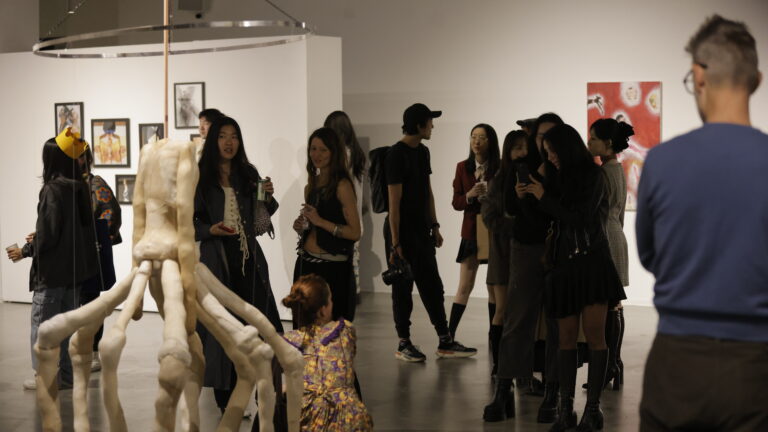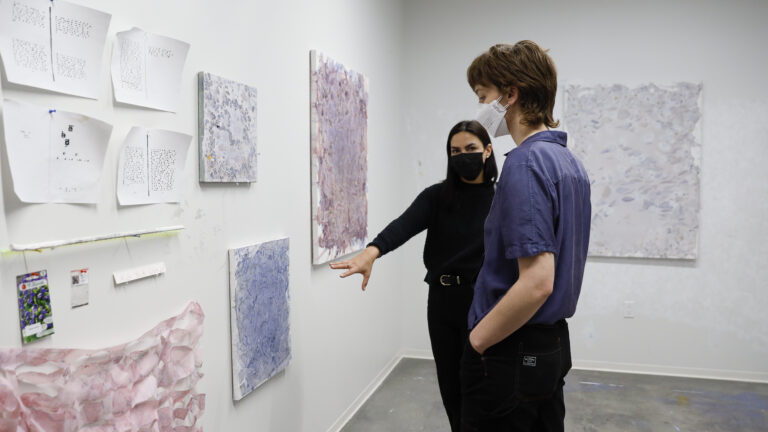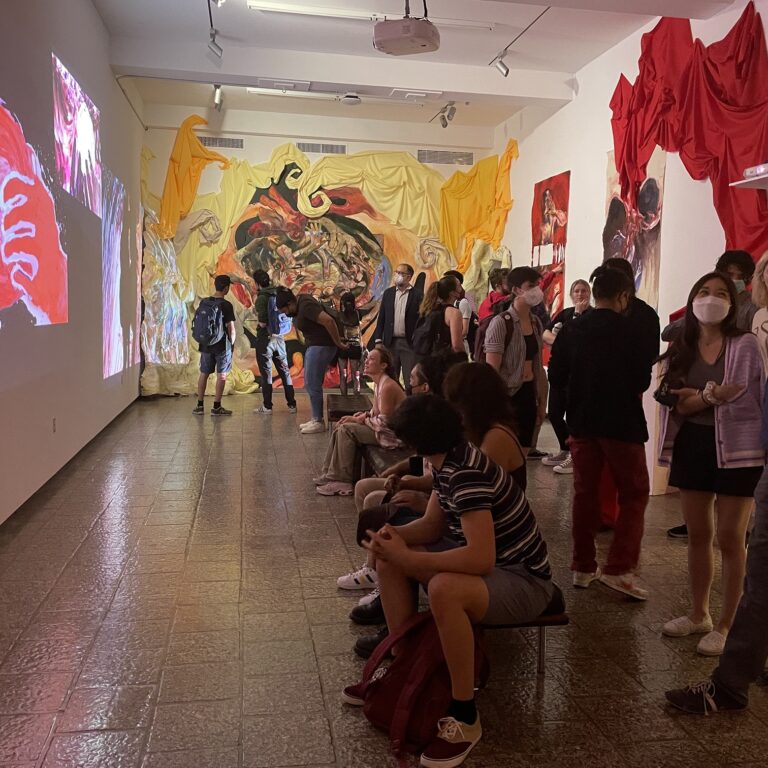Graduate Admission

USC Roski Master’s Degree Programs
Important Deadlines
MFA Art deadline is January 15, for Fall admission
MA Curatorial Practices and the Public Sphere deadline is January 15, for priority Fall admission
MFA Design deadline is January 15, for priority Fall admission
MFA Fashion deadline is January 15, for priority Fall admission
—
Priority deadline is for departmental award consideration. Application submission for MA, MFA Design and MFA Fashion will be accepted thru end of May on a space-available basis.
Spring admission is not available for all of the above programs

Fall Graduate Info Sessions
We encourage you to attend one of our graduate info sessions in the fall, either in person or online. At one of these informative open-house events, you can learn about application requirements and your program, ask questions and take a tour of the Roski Graduate Building in the L.A. Arts District.
Eligibility and Requirements
Admission to USC Roski Master’s degree programs is competitive. All applicants must hold a BFA, BA, or equivalent from an accredited institution, submit a USC Graduate Application, and meet all application requirements. If you are applying to the MFA Design program, your BFA/BA degree should be in a creative field (design, art, architecture) or a relevant field with some practice (business, communication, etc).
Portfolio Requirement
If you are applying to the MFA Art or MFA Design degree program, you are also required to submit a portfolio. See below…
Applying to USC Roski
Your graduate application to USC Roski is made up of several elements: The online USC Graduate Application and additional materials, some of which are program-specific.
-
All prospective graduate students apply online using the required USC Graduate Application. You may return to work on your application over several sessions before submitting it for review by the Admission staff.
-
When you are ready to submit your application, you must pay the USC $90 application fee via credit card. Students who qualify for a fee waiver should make the appropriate selection on their application and submit supporting documents to demonstrate qualification.
Check if you are eligible for the fee waiver.
If you are applying to the MFA Art or MFA Design program, you must also pay a SlideRoom fee of $20 before your application will be processed.
-
Aside from your online application, you’ll need to submit additional materials if you are applying for the USC Roski MFA Art, MFA Design or MA degree programs.
Applicants to all graduate degree programs must submit the following:
Official Transcripts
Request your official transcripts from the registrar’s offices of all post-secondary schools you have attended. Unofficial transcripts or documents printed from online student portals will not be accepted.
Transcripts should be sent to the USC Office of Admission.
Curriculum Vitae or Resume
Please upload this document detailing your employment, education, extra-curricular collegiate and community activities, honors, awards, publications, professional organizations, travel and any other relevant information you would like to include. Be sure to get advice on formatting and organizing the c.v. from a professor or arts professional.
-
In addition to the items above, you must submit the following:
- An Artist Statement of 500 words or less
- Three (3) Letters of Recommendation
- A Portfolio (see below)
NOTE: It is not necessary to complete the “Supporting Information” section in the Graduate Application. We prefer that you upload your resumé or CV, Artist Statement, as well as a Portfolio via SlideRoom. You will still need to click through the “Supporting Information” section, and “opt-out” of submitting information there.
Your Portfolio
Portfolio submissions to accompany your application to the MFA Art program should include one or more of the following:
- Still images (20 – 25 images). Please use Slideroom’s Media Details feature to input titles, medium, dimensions and year of creation for each image submitted. The images should constitute a cohesive body of work, while also providing a sense of the scope of the applicant’s practice.
- Non-Interactive media (video, film, performance documentation, animation). If the work exceeds Slideroom’s 60MB capacity you may post works online and provide a link.
IMPORTANT NOTE: You must use Slideroom’s Documents file as an easy option to indicate the presence of time-based work posted online. The faculty admissions committee will review your work and will not find the alternatively provided materials without your bringing it to their attention. For group or collaborative projects, be sure to indicate your role. For excerpts of video projects, it is especially important to include information to contextualize the clip provided. - Interactive media (interactive DVD-Video, Flash, HTML, Director, etc). You may post interactive works online and provide a link, as instructed above. Interactive media should be prepared as a guided tour or linear movie. Text or voice annotation should be provided as necessary, as well as sufficient screen or video captures. Be sure to provide a synopsis of each interactive piece, including the title and date created. The recommended pixel dimensions for any video project are no less than 640 x 480 (standard) or 720 x 480 (wide screen). You may wish to include a recommended viewing size for playback on a PC or Mac.
Applicants must submit both Roski’s Slideroom Application Form and USC’s Application for Graduate Admission. You can find the portal to Slideroom inside the USC Graduate Application in the Program Materials section. Use only this portal to access Slideroom; otherwise the two applications will not synchronize correctly.
-
Applicants to the USC Roski MFA Design program must additionally submit the following:
- A Design Statement of 500 words maximum
- Three (3) Letters of recommendation
- A Portfolio (see below)
NOTE: It is not necessary to complete the “Supporting Information” section in the Graduate Application. We prefer that you upload your resumé or CV, Artist Statement, as well as a Portfolio via SlideRoom. You will still need to click through the “Supporting Information” section, and “opt-out” of submitting information there.
Your Portfolio
Portfolio submissions for the MFA Design program should include one or more of the following:
- Still images (20–25 images). Please use Slideroom’s Media Details feature to input titles, medium, dimensions, and year of creation for each image submitted. The images should constitute a cohesive body of work, while also providing a sense of the scope of your practice.
- Non-Interactive media (video, film, performance documentation, animation). If the work exceeds Slideroom’s 60MB capacity you may post works online and provide a link.
IMPORTANT NOTE: Applicants must utilize Slideroom’s Documents file as an easy option to indicate the presence of time-based work posted online. The faculty admissions committee will review your work and will not find the alternatively provided materials without your bringing it to their attention. For group or collaborative projects, be sure to indicate your role. For excerpts of video projects, it is especially important to include information to contextualize the clip provided.
- Interactive media (interactive DVD-Video, Flash, HTML, Director, etc.). Applicants may post interactive works online and provide a link, as instructed above. Interactive media should be prepared as a guided tour or linear movie. Text or voice annotation should be provided as necessary, as well as sufficient screen or video captures. Be sure to provide a synopsis of each interactive piece, including the title and date created. The recommended pixel dimensions for any video project is no less that 640 x 480 (standard) or 720 x 480 (wide screen). You may wish to include a recommended viewing size for playback on a PC or Mac.
-
If you are applying to the Masters in Curatorial Studies and the Public Sphere program, you will need to additionally submit the following:
Three Letters of Recommendation
You are required to submit three (3) Letters of Recommendation from instructors or persons able to comment on your artistic and/or scholarly research and potential as a graduate student. Try to get at least two letters from academic supporters; the third can be from an academic or professional supporter (for example, a gallery director or supervisor in an arts organization). If this is impossible, let us know why in your Personal Statement.
Writing Sample
To demonstrate your writing skills, please include at least one academic paper, preferably 15–30 pages in length. (If you have no academic writing to submit, please let us know why in your Personal Statement.)
Ideally, your sample should be a paper that shows evidence of research and writing skills, including academic footnotes or in-text references, and with bibliography. The paper does not have to be on an art-related topic, but this would be ideal. The arguments should show critical thinking. If you have published professionally (short catalogue entries, for example), feel free to include a few of those in addition to the academic paper.
Curatorial Essay
Please submit an essay of 500 words maximum describing an exhibition you would like to curate, or reviewing an exhibition you have seen that informs your curatorial ideas and/or research goals. Provide an overview of the proposed/reviewed exhibition, and highlight the key artist(s), artworks and curatorial themes that motivate your application.
Personal Statement
Ideally, the statement should achieve the following:
- Clarify your interest in our program, making note of people at Roski with whom you might want to work
- Outline any anomalies in your academic or professional record, gaps in your timeline, shifts in interest over your studies and work, so that we may better understand your background.
- Make note of particular pressures or experiences that have informed your life and studies and/or work in the arts.
-
International applicants whose native language is not English must submit a TOEFL, IELTS or PTE test score earned within two years of their application date. Please visit the USC Graduate Admission website for English Proficiency Expectations.
If you are sending TOEFL scores, the institution code for USC is 4852 (no department code required). If you are sending IELTS scores, please choose USC from the list of available institutions.
The scores must be submitted electronically to USC from ETS to be considered official. Photocopies or paper copies of scores are not acceptable as official submission.
Learn more about USC language requirements
Financial Statement
Admission to the Roski School of Art and Design is based on merit, and not on ability to pay. But the U.S. government requires all international applicants to provide proof of adequate financial support and passport copies for you and any applicable dependents before a formal letter of admission and an I-20 or DS-2019 can be issued. International students should also complete the Financial Statement of Personal or Family Support, along with bank verification documents.
To learn more about our tuition and administrative fees, financial document submission guidelines and immigration procedures, please go to the USC Admissions website.
-
- Official copies of all college transcripts should be submitted directly to the USC Office of Admission.
- Letters of Recommendation should be sent electronically via the online USC Graduate Application, our preferred method of submission. If necessary, letters may also be sent in hard copy form directly from your recommender(s) to the USC Roski School of Art and Design.
- MFA applicants: We prefer that you upload your CV and Artist/Design Statement to SlideRoom along with your Portfolio, rather than via the online application.
- MA applicants: CV, Personal Statement, Curatorial Essay and Writing Sample should be uploaded as part of the online application.
How to Submit Materials
- Official copies of all college transcripts should be submitted directly to the USC Office of Admission.
- Official test scores should be sent from the testing agency directly to USC. USC’s ETS school code is 4852.
- Letters of Recommendation should be sent electronically via the online USC Graduate Application, our preferred method of submission. If necessary, letters may also be sent in hard copy form directly from your recommender(s) to the USC Roski School of Art and Design.
- MFA applicants: We prefer that you upload your CV and Artist/Design Statement to SlideRoom along with your Portfolio, rather than via the online application.
- MA applicants: CV, Personal Statement, Curatorial Essay and Writing Sample should be uploaded as part of the online application.
After You Apply
You will receive your 10-digit USC ID number via email within two to three business days after you submit your online application. It is important to remember that this ID number is different from the one that appears on your USC Graduate Application. Please keep this ID on record and make sure to include it in all your communication with USC. You will also need to include it when mailing any documents to the university.
